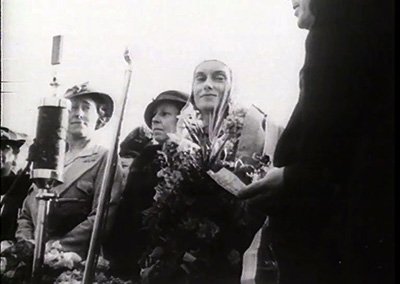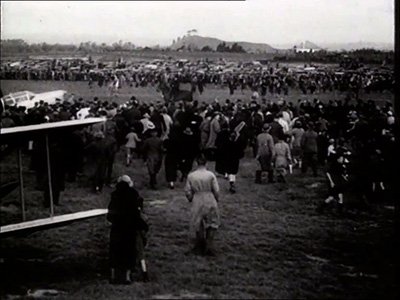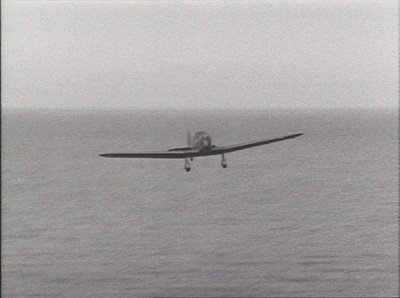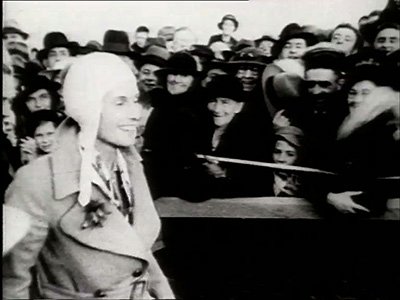
By Ellen Pullar
Although Batten broke world flying records several times over, this was the longest of all of her journeys. Always a solo flyer, her long-distance flights were incredible feats of mental and physical endurance. Her flight from England to Auckland flight covered 14,000 miles, including 1,300 miles over the Tasman Sea – a leg of the trip that was believed to be particularly dangerous, with media commentators criticising the risk she was taking. This leg of the trip alone took her ten and half hours. She flew in a small Percival Gull monoplane. She left England at 3.30am on the 5th of October and landed in Auckland eleven days later, on the evening of October 16.
Hero image: Jean Batten holding flowers, after landing in Auckland - 'Jean Batten – The Garbo of the Skies' (Ian MacKersey, 1988).

Batten addresses the media in Australia, before her final leg across the Tasman Sea - 'Jean Batten – Garbo of the Skies' (Ian MacKersey, 1988).
Batten was given the title Hine-o-te-Rangi (“Daughter of the Skies”) by local Māori in her birthplace Rotorua. The media also gave her another nickname: “Garbo of the Skies.” At the time Greta Garbo was Hollywood’s biggest star – like Garbo, Batten was known for her glamour, her high profile romances and her periods of reclusiveness.

Crowds gathered in Auckland, awaiting Jean Batten's arrival in 1936 - 'Jean Batten – Garbo of the Skies' (Ian MacKersey, 1988).
The glamour she cultivated is apparent in press descriptions of Batten from the 1930s, which relish her well-put-together appearance when departing or arriving on her long flights. She typically flew in a crisp, white pair of overalls, and arrived fully made-up, often in elegant full-length coats – this in spite of her understandable exhaustion! On her arrival in Auckland, the reporter for the Evening Post noted:
“Renewed cheers burst from every mouth as the girl aviator, looking fresh and charming in her white overalls and flying helmet, and as well-groomed as if she had been for a few minutes’ flight, undid the cockpit cover and waved to the crowd.” (Evening Post, 17 October 1936, p. 14)

Batten’s plane appearing on the horizon - 'Jean Batten – Garbo of the Skies' (Ian MacKersey, 1988).
The Auckland Star reporter was similarly impressed. This report bursts with a level of genuine pride and amazement, cutting through the usual 1930s vernacular deployed when discussing women and female achievement:
“When she stepped from the plane, the seas of enthusiasm ran mountains high. It was a moment that will be long remembered – this white-helmeted, neat slip of a girl, nonchalantly stepping from her machine fresh, bright, and with not the slightest trace of fatigue. She waved a hand to the shouting crowd, and then with a flashing smile jumped to the ground. History was made by this 26-year-old Auckland girl, and records tottered and crashed as her silver plane flashed through the skies in one of the greatest flights the world has ever known.” (Auckland Star, 17 October 1936, p. 10)

Batten descending from her plane in Auckland - 'Jean Batten – Garbo of the Skies' (Ian MacKersey, 1988)
The “Garbo of the Skies” moniker stuck. Garbo of the Skies, is the name of a 1988 documentary about Batten directed by Ian MacKersey (as well as a 1990 biographical novel, also by Ian Mackersey, and a 2008 play by Paul Andersen-Gardiner and Rebekah Hornblow). The documentary, Jean Batten – Garbo of the Skies, is part of the Ngā Taonga Sound & Vision collection. It weaves archival footage, contemporary location footage, clippings, photographs, and quotes from Batten’s letters and diary together to tell the story of the life of “the aviator with the glamorous exterior.”
The full 52-minute film can be watched in the viewing libraries at Ngā Taonga Sound & Vision in Wellington.
Check out Batten’s 1938 autobiography, My Life (New Zealand Electronic Text Collection - held by Victoria University).